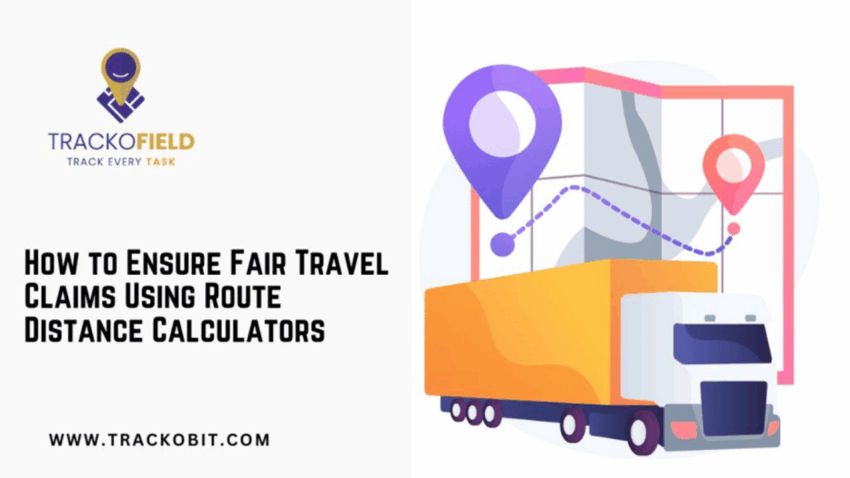Learn to optimise travel expense claims with route distance calculators. Use field employee tracking system to verify expenses and check staff productivity.
How to Ensure Fair Travel Claims Using Route Distance Calculators
Be it salesmen, service technicians or delivery agents, all field executives spend a significant part of their day travelling from one client to another.
Therefore, it’s essential for companies to optimise travel routes, ensure a system to reimburse conveyance charges and prevent delays in reaching task sites.
This is only possible by using a field employee management toll with embedded route distance calculator. It can automatically calculate the daily distance travelled by an agent, generate fuel costs, show traffic data and more.
Dive in to know how an automatic route distance calculator works and why it is necessary for your field business.
Why Fair Travel Claims Matter In a Field Business
Whether your business reimburses employees per kilometre, offers fuel allowances, or covers public transport expenses, the goal is the same: to pay fairly for the actual distance travelled for work purposes.
But it’s important to verify employees’ expense requests. Without proper checks,
- Employees might overstate distances for personal gain.
- Managers may underestimate travel time, leading to unpaid hours.
- HR teams waste hours manually verifying travel logs and maps.
- The business bleeds money through inflated or fraudulent claims.
What Is a Route Distance Calculator?
A route distance calculator is a digital tool that:
- Calculates the distance between two or more locations.
- Factors in actual road routes, not just straight-line distances.
- May integrate traffic data, weather, and real-time travel conditions
- Provides the most efficient or commonly used routes
These calculators are built into many field force management systems and travel claim apps, often integrated by a skilled WordPress developer to streamline backend functionality.
Benefits of Using Route Distance Calculators
1. Less Guesswork and Estimation
Instead of relying on an employee’s memory or handwritten logs, the route distance calculators gives an accurate timeline of an employees’ travel history. Every mile and every stop are accounted for.
Since field employee tracking software is automated and data-driven, there are no disputes regarding mileage.
2. Reduced Fraud and Over-Reporting
Without route tracking, an employee might:
- Inflate distances due to unnecessary detours
- Disguise personal errands as work travel
- Claim multiple trips that didn’t happen
But a route distance calculator helps field managers avoid these issues. It:
- Suggests shortest or most logical routes
- Compares actual distances to claimed distances
- Flags suspicious discrepancies are flagged automatically
3. Standardized Claims Across the Company
If 10 field reps visit the same client site from the same office, they shouldn’t all claim different distances.
A route distance calculator helps:
- Create a standard route list
- Set maximum allowable distances for routine journeys
- Ensure fair and equal reimbursement for everyone
4. Integration With Field Employee Tracking Systems
Modern field employee tracking software like TrackoField combines:
- GPS employee tracking
- Task check-ins
- Route mapping
- Auto-calculated distance logs
This makes travel claim submissions automation, tamper-proof and transparent for both executives and managers.
5. Time Management
Manually verifying travel logs is time-consuming. A route distance calculator can help the HR and Management teams to:
- Auto-generate travel logs
- Compare them with actual GPS routes
- Flag discrepancies
- Feed clean data directly into payroll software
How to Use Route Distance Calculators Effectively
Step 1: Set Guidelines
Create clear rules:
- Per-kilometer reimbursement rates
- What qualifies as business travel
- Which routes are approved or reimbursable
Step 2: Look for Field Force Management Software
Most FFM software are equipped with route calculators and geofences. These help to verify:
- Daily task assignment
- Employee check-in/check-out workflows
- Expense requests.
Thus, you create a paperless, real-time, and fair travel claim system.
Step 3: Set Limits and Exceptions
Just because you have a reimbursement policy it doesn’t mean your field reps can raise any number of expense requests.
- Set standard distances for repeat journeys
- Allow flexibility for valid route changes (road closures, etc.)
- Keep a process for reviewing and approving exceptions
- Create an upper limit for expenses
Step 4: Educate Employees
Employees should know:
- How travel is tracked.
- How the calculator works.
- How to check or correct errors.
- That the system is fair and not about surveillance, but accuracy.
An Insightful Case-Study
A sales rep visits a client in another city every week. He used to claim 60 km travel one way, but GPS route tracking consistently shows 48 km. By switching to field employee tracking system, the company:
- Saved 24 km per round trip
- Cut monthly fuel reimbursements by 15%
- Improved trust and eliminated debates over travel logs
Conclusion
Ensuring fair travel claims cuts costs, but it also improves your employees’ daily work habits. They travel less, reduce fuel wastage and visit more clients.
This creates a culture of transparency and accountability where every reimbursement is fair and easy to verify. And the credit goes to field employee tracking systems with integrated route distance calculators.
These tools can completely transform your field business. Don’t believe us? Try a free demo of TrackoField and experience it yourself.

